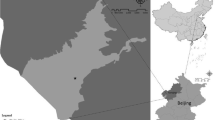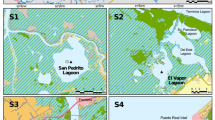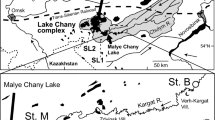Abstract
Ecological restoration actions to improve hydrologic conditions, including the construction of levees and freshwater release have been widely used to restore wetlands degraded by excessive soil salinity in coastal areas. However, the construction of levees for impoundments blocks the connectivity between the restored wetlands and the sea. In addition, freshwater inputs also altered some physical and chemical properties of the water bodies. In this study, stable isotopic compositions of primary producers and the shared consumers were analyzed to evaluate the impacts of these hydrologic changes on the function of the restored wetland ecosystems. After freshwater inputs, due to the change in salinity, the vegetation of the restored wetlands was replaced by the freshwater wetland vegetation. Although significant differences in the composition of basal sources existed, carbon stable isotope analyses indicated that there were no significant changes in source contribution between natural and restored wetlands for the shared consumers, with Suspended POM/ submersed aquatic vegetation being identified as contributing more carbon sources to consumers than emergent macrophytes/sediments. The construction of the impoundments eliminated the natural hydrological connection between the restored wetlands and the ocean, leading to the oligotrophic conditions in restored wetlands. For shared consumers, the δ15N values and trophic level positions in the restored wetlands became significantly lower than that in the natural wetlands.




Similar content being viewed by others
Data Availability
All data generated or analysed during this study are included in this published article.
References
Chi Y, Zheng W, Shi HH et al (2018) Spatial heterogeneity of estuarine wetland ecosystem health influenced by complex natural and anthropogenic factors. Science of the Total Environment 634:1445–1462
Christianen MJA, Middelburg JJ, Holthuijsen SJ et al (2017) Benthic primary producers are key to sustain the Wadden Sea food web: stable carbon isotope analysis at landscape scale. Ecology 98(6):1498–1512
Costanza RO, Perez-Maqueo O, Martinez ML et al (2008) The value of coastal wetlands for hurricane protection. Ambio: A Journal of the Human Environment 37:241–248
Elliott M, Mander L, Mazik K et al (2016) Ecoengineering with Ecohydrology: Successes and failures in estuarine restoration. Estuarine, Coastal and Shelf Science 176:12–35
Garcia AM, Winemiller KO, Hoeinghaus DJ et al (2017) Hydrologic pulsing promotes spatial connectivity and food web subsidies in a subtropical coastal ecosystem. Marine Ecology Progress Series 567:17–28
Giosan L, Syvitski J, Constantinescu S et al (2014) Climate change: protect the world’s deltas. Nature 516(7529):31
Guan Q, Wu HT, Lu KL et al (2017) Longitudinal and lateral variation in snail assemblages along a flood plain continuum. Hydrobiologia 792(1):345–356
Hua YY, Cui BS, He WJ (2012) Changes in water birds habitat suitability following wetland restoration in the Yellow River Delta, China. Clean-Soil Air Water 40(10):1076–1084
Kennish MJ (2002) Environmental threats and environmental future of esturies. Environmental Conservation 29(1):78–107
Layman CA, Araujo MS, Boucek R et al (2012) Applying stable isotopes to examine food-web structure: an overview of analytical tools. Biological Reviews 87:545–562
Lotze HK, Lenihan HS, Bourque BJ et al (2006) Depletion, degradation, and recovery potential of estuaries and coastal seas. Science 312(5781):1806–1809
Loucks DP (2019) Developed river deltas: are they sustainable? Environmental Research Letters 14(11):1–15
Lu KL, Wu HT, Xue ZS et al (2019) Development of a multi-metric index based on aquatic invertebrates to assess floodplain wetland condition. Hydrobiologia 827:141–153
Morse JC, Yang LF, Tian LX (1994) Aquatic insects of China useful for monitoring water quality. HoHai University Press, Nanjing
Newton A, Carruthers TJ, Icely J (2012) The coastal syndromes and hotspots on the coast. Estuarine, Coastal and Shelf Science 96:39–47
Nordstrom MC, Demopoulos AWJ, Whitcraft CR et al (2015) Food web heterogeneity and succession in created saltmarshes. Journal of Applied Ecology 52:1343–1354
Parr TB, Capps KA, Inamdar SP et al (2019) Animal-mediated organic matter transformation: Aquatic insects as a source of microbially bioavailable organic nutrients and energy. Functional Ecology 33(3):524–535
Philips DL, Inger R, Bearhop S et al (2014) Best practices for use of stable isotope mixing models in food-web studies. Canadian Journal of Zoology 92:823–835
Pimm SL, Lawton JH, Cohen JE (1991) Food web patterns and their consequences. Nature 350(6320):669–674
Post DM (2002) Using stable isotopes to estimate trophic position: Models, methods, and assumptions. Ecology 83(3):703–718
Prather CM, Pelini SL, Laws A et al (2013) Invertebrates, ecosystem services and climate change. Biological Reviews 88(2):327–348
Ruhi A, Batzer DP (2014) Assessing congruence and surrogacy among wetland macroinvertebrate taxa towards efficiently measuring biodiversity. Wetlands 34:1061–1071
Scavia DS, Field JC, Boesch DF et al (2002) Climate change impacts on U.S. costal and marine ecosystems. Estuaries 25(2):149–164
Sheaves M, Baker R, Nagelkerken I et al (2015) True value of Estuarine and Coastal Nurseries for Fish: Incorporating complexity and dynamics. Estuaries and Coasts 38(2):401–414
Sims A, Zhang YY, Galaraj S et al (2013) Toward the development of microbial indicators for wetland assessment. Water Research 47(5):1711–1725
Tang N, Cui BS, Zhao XS (2006) The restoration of reed (Phragmites australi) wetland in the Yellow River Delta. Acta Ecologica Sinica 26(8):2616–2624
Walton MEM, Vilas C, Coccia C et al (2015) The effect of water management on extensive aquaculture food webs in the reconstructed wetlands of the Doñana Natural Park, Southern Spain. Aquaculture 448:451–463
Wang XH, Yu JB, Zhou D et al (2012) Vegetative ecological characteristics of restored reed (Phragmites australis) wetlands in the Yellow River Delta, China. Environmental Management 49:325–333
Wu HT, Guan Q, Lu XG et al (2017) Snail (Mollusca:Gastropoda) assemblages as indicators of ecological condition in freshwater wetlands of Northeast China. Ecological Indicators 75:203–209
Wu HT, Guan Q, Ma HY et al (2019) Effects of saline conditions and hydrologic permanence on snail assemblages in wetlands of Northeastern China. Ecological Indicators 96:620–627
Yang W, Li XX, Sun T et al (2017) Macrobenthos functional groups as indicators of ecological restoration in the northern part of China’s Yellow River Delta Wetlands. Ecological Indicators 82:381–391
Yang MY, Lu KL, Batzer DP, Wu HT (2019) Freshwater release into estuarine wetlands changes the structure of benthic invertebrate assemblages: A case study from the Yellow River Delta. Science of the Total Environment 687:752–758
Zhao QQ, Bai JH, Huang LB et al (2015) A review of methodologies and success indicators for coastal wetland restoration. Ecological Indicators 60:442–452
Acknowledgements
We appreciate the help from taxonomic experts Baoquan Li and Fuyi Yang. This study was supported by the National Natural Science Foundation for Young Scientists of China (41801084), the National Key R&D Program of China (2017YFC0505901), the National Natural Science Foundation of China (41871099, 41671260), China Postdoctoral Science Foundation (194419), and Jilin Scientific and Technological Development Program (20180101080JC). DPB was supported by the USDA Hatch Program.
Funding
This study was supported by the National Natural Science Foundation for Young Scientists of China (41801084), the National Key R&D Program of China (2017YFC0505901), the National Natural Science Foundation of China (41871099, 41671260), China Postdoctoral Science Foundation (194419), and Jilin Scientific and Technological Development Program (20180101080JC). DPB was supported by the USDA Hatch Program.
Author information
Authors and Affiliations
Contributions
All authors contributed to the study conception and design. Material preparation, data collection and analysis were performed by HTW, MYY and KLL. The first draft of the manuscript was written by MYY. And DPB helped to revise the manuscript with constructive discussions. All authors read and approved the final manuscript.
Corresponding author
Ethics declarations
Ethics Approval
Not applicable.
Consent to Participate
Not applicable.
Consent for Publication
Not applicable.
Conflicts of Interest/Competing Interests
The authors have declared that no conflict of interest exists.
Code Availability
These Bayesian mixing models were used to estimate the percent contributions of specific basal sources to consumer biomasses in R with the simmr package.
Additional information
Publisher’s note
Springer Nature remains neutral with regard to jurisdictional claims in published maps and institutional affiliations.
Rights and permissions
About this article
Cite this article
Wu, H.T., Yang, M.Y., Lu, K.L. et al. Effects of Ecological Restoration on Trophic Dynamics in Estuarine Wetlands. Wetlands 41, 10 (2021). https://doi.org/10.1007/s13157-021-01408-7
Received:
Revised:
Accepted:
Published:
DOI: https://doi.org/10.1007/s13157-021-01408-7




